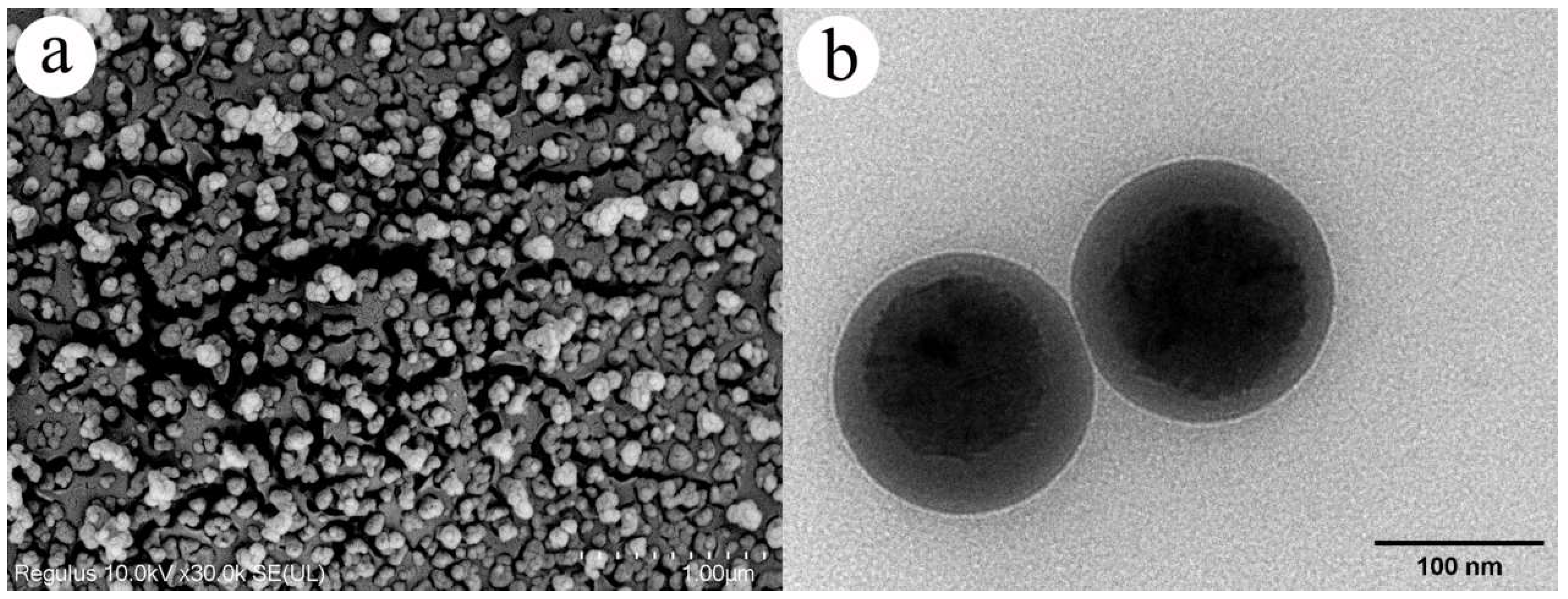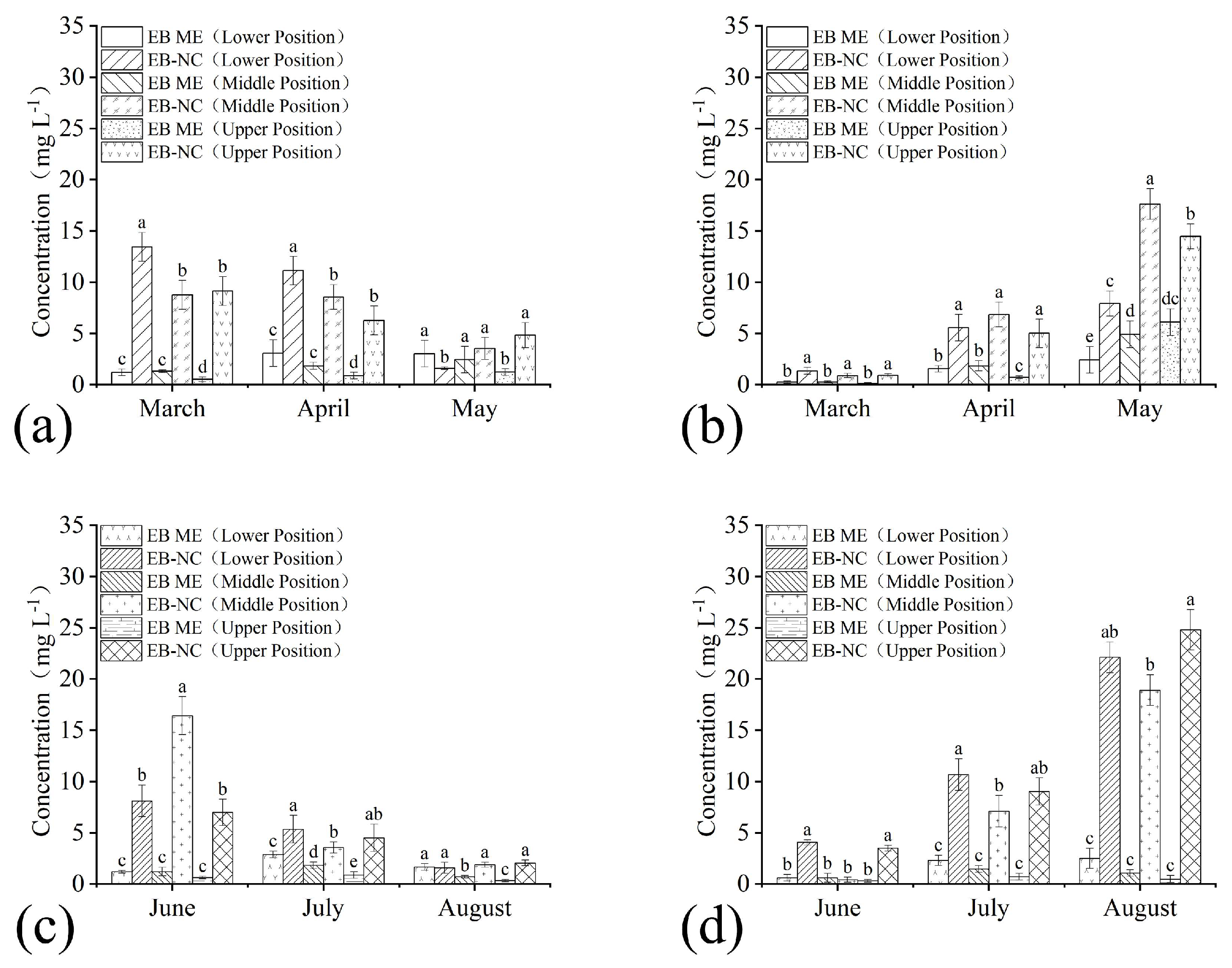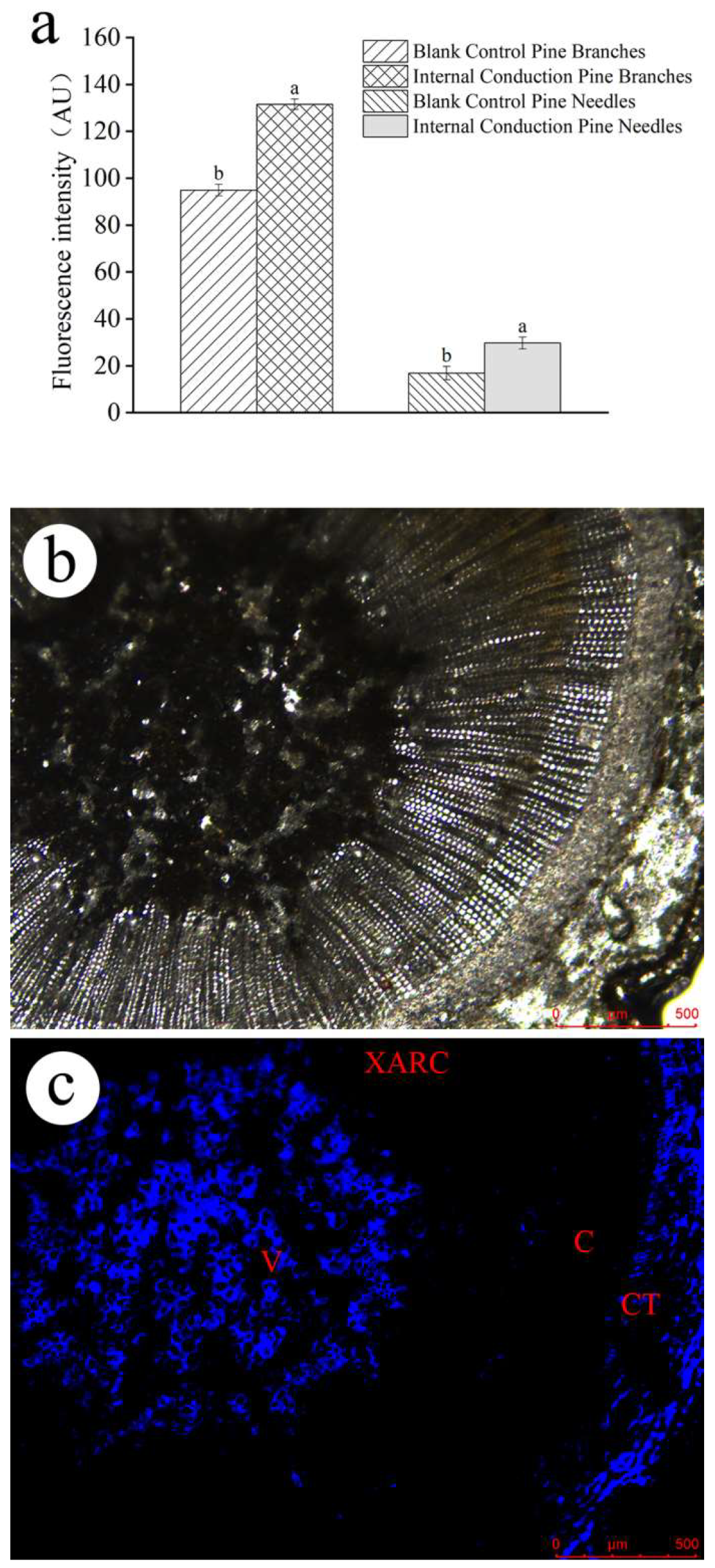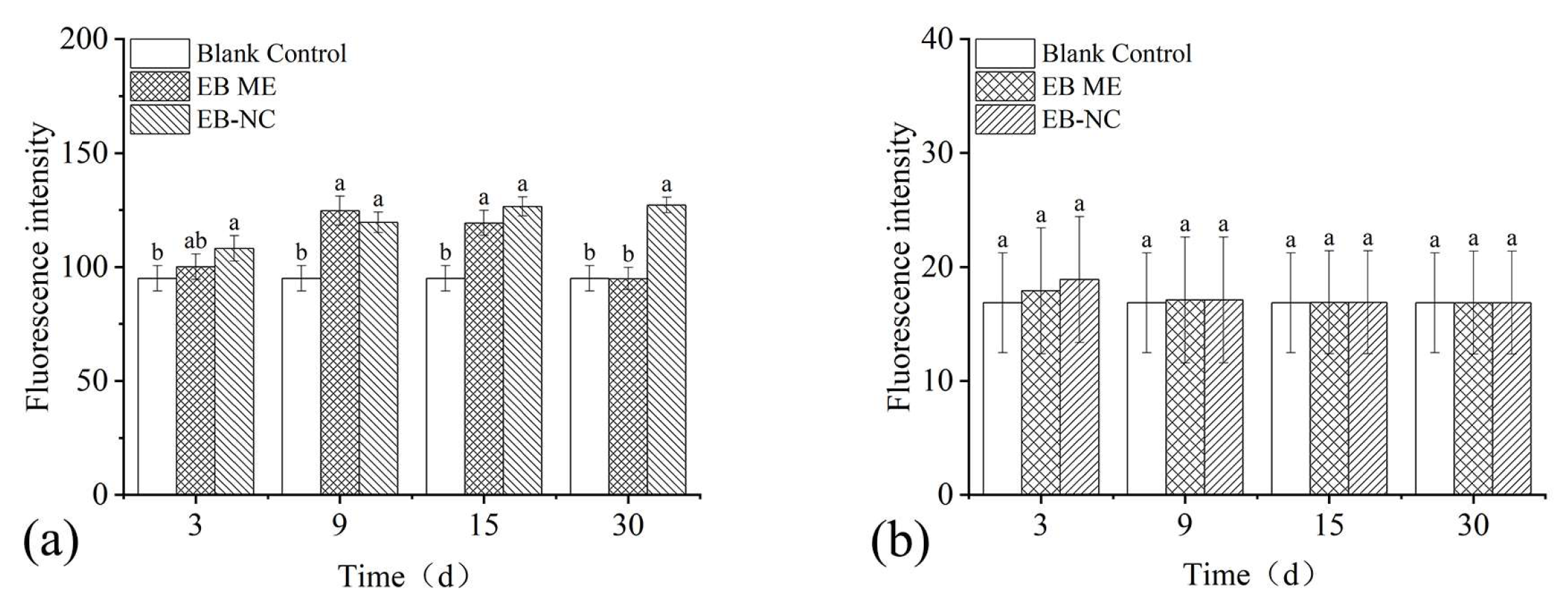Characteristics and Conductivity of Emamectin Benzoate-Inclusive Nanocapsule in Pinus massoniana Lamb.
Abstract
:1. Introduction
2. Materials and Methods
2.1. Preparation of EB-NC Formulation
2.2. Determination of EB-NC Characteristics
2.2.1. Microscopy
2.2.2. EB-NC Photostability
2.2.3. EB-NC Slow-Release Properties
2.3. Indoor EB-NC Toxicity Assay against PWNs
2.4. Conductivity Distribution Dynamics of EB-NC Trunk Injection in Pinus massoniana
2.5. In Situ Fluorescent Detection of EB in Trunk-Injected Pine Trees
2.6. Conductivity Properties of EB in EB-NC-Sprayed Pinus massoniana
2.6.1. Fluorescence Localization to EB after Spray Conductance
2.6.2. Detection of EB Residues after Spray Conduction
2.7. Data Analysis
3. Results
3.1. Characteristics of EB-NCs
3.2. EB Conduction Dynamics in Pinus massoniana with Trunk Injection
3.3. EB-NC Formulation Conductivity Properties in P. massoniana with Spray Application
4. Discussion
5. Conclusions
Supplementary Materials
Author Contributions
Funding
Data Availability Statement
Conflicts of Interest
References
- Robinet, C.; Roques, A.; Pan, H.; Fang, G.; Ye, J.; Zhang, Y.; Sun, J. Role of human-mediated dispersal in the spread of the pinewood nematode in China. PLoS ONE 2009, 4, e4646. [Google Scholar] [CrossRef] [PubMed]
- Cardoso, J.M.S.; Anjo, S.I.; Fonseca, L.; Egas, C.; Manadas, B.; Abrantes, I. Bursaphelenchus xylophilus and B. mucronatus secretomes: A comparative proteomic analysis. Sci. Rep. 2016, 6, 39007. [Google Scholar] [CrossRef] [PubMed]
- Mamiya, Y. Scanning Electron microscopy of pine seedling wood tissue sections inoculated with the pine wood nematode Bursaphelenchus xylophilus previously prepared for light microscopy. J. Nematol. 2012, 44, 255–259. [Google Scholar] [PubMed]
- Padmavathi, V.; Alagesan, K.; Alhowaity, A.; Khan, M.I.; Hamam, H.; Angayarkanni, M.; Govindan, V. Analysis and numerical simulation of fractional order pine wilt disease model. Int. J. Mod. Phys. B 2022, 36. [Google Scholar] [CrossRef]
- Iwahori, H.; Tsuda, K.; Kanzaki, N.; Izui, K.; Futai, K. PCR-RFLP and sequencing analysis of ribosomal DNA of Bursaphelenchus nematodes related to pine wilt disease. Fundam. Appl. Nematol. 1998, 21, 655–666. [Google Scholar]
- Yang, Z.Q.; Wang, X.Y.; Zhang, Y.N. Recent advances in biological control of important native and invasive forest pests in China. Biol. Control 2014, 68, 117–128. [Google Scholar] [CrossRef]
- Li, G.H.; Zhang, K.Q. Natural nematicidal metabolites and advances in their biocontrol capacity on plant parasitic nematodes. Nat. Prod. Rep. 2023, 40, 646–675. [Google Scholar] [CrossRef] [PubMed]
- Jeon, H.W.; Park, A.R.; Sung, M.; Kim, N.; Mannaa, M.; Han, G.; Kim, J.; Koo, Y.; Seo, Y.S.; Kim, J.C. Systemic Acquired Resistance-Mediated Control of Pine Wilt Disease by Foliar Application With Methyl Salicylate. Front. Plant Sci. 2022, 12, 812414. [Google Scholar] [CrossRef]
- Takai, K.; Suzuki, T.; Kawazu, K. Development and preventative effect against pine wilt disease of a novel liquid formulation of emamectin benzoate. Pestic. Manag. Sci. 2003, 59, 365–370. [Google Scholar] [CrossRef]
- Sousa, E.; Naves, P.; Vieira, M. Prevention of pine wilt disease induced by Bursaphelenchus xylophilus and Monochamus galloprovincialis by trunk injection of emamectin benzoate. Phytoparasitica 2013, 41, 143–148. [Google Scholar] [CrossRef]
- Pan, W.H.; Wu, J.L.; Jia, J.W.; Zhang, S.Y.; Ma, L.J.; Chen, A.L. Control effect of trunk injection of emamectin benzoate against pine wilt disease. Pestic. Dis. 2014, 33, 41–44. [Google Scholar]
- Ishaaya, I.; Kontsedalov, S.; Horowitz, A.R. Emamectin, a novel insecticide for controlling field crop pests. Pestic. Manag. Sci. 2002, 58, 1091–1095. [Google Scholar] [CrossRef] [PubMed]
- Takai, K.; Soejima, T.; Suzuki, T.; Kawazu, K. Development of a water-soluble preparation of emamectin benzoate and its preventative effect against the wilting of pot-grown pine trees inoculated with the pine wood nematode, Bursaphelenchus xylophilus. Pestic. Manag. Sci. 2001, 57, 463–466. [Google Scholar] [CrossRef]
- Elabasy, A.; Shoaib, A.; Waqa, S.M.; Jiang, M.; Shi, Z. Synthesis, characterization, and pesticidal activity of emamectin benzoate nanoformulations against Phenacoccus solenopsis Tinsley (Hemiptera: Pseudococcidae). Molecules 2019, 24, 2801. [Google Scholar] [CrossRef] [PubMed]
- Song, S.; Wang, Y.; Xie, J.; Sun, B.; Zhou, N.; Shen, H.; Shen, J. Carboxymethyl chitosan modified carbon nanoparticle for controlled emamectin benzoate delivery: Improved solubility, pH-responsive release, and sustainable pest control. ACS Appl. Mater. Interfaces 2019, 11, 34258–34267. [Google Scholar] [CrossRef] [PubMed]
- Cui, J.; Mo, D.; Jiang, Y.; Gab, C.F.; Li, Q.G.; Wu, A.; Li, X.Y.; Xiao, J.A.; Hu, Q.; Yuan, H.Y.; et al. Fabrication, characterization, and insecticidal activity evaluation of emamectin benzoate–sodium lignosulfonate nanoformulation with pH-responsivity. Ind. Eng. Chem. Res. 2019, 58, 19741–19751. [Google Scholar] [CrossRef]
- Long, Y.; Zhang, H.; Liao, G.; Chen, M.; Chen, X.; Qin, L.; Chen, C.; Chen, Z.; Wu, X.; Zhu, F. Distribution of emamectin benzoate granules in maize plants by broadcasting into maize leaf whorls. ACS Omege 2023, 8, 4209–4219. [Google Scholar] [CrossRef]
- Gao, F.; Cui, B.; Wang, C.; Li, X.; Li, B.; Zhan, S.; Shen, Y.; Zhao, X.; Sun, C.; Wang, C.; et al. Nano-EMB SP improves the solubility, foliar affinity, photostability and bioactivity of emamectin benzoate. Pestic. Manag. Sci. 2022, 78, 3717–3724. [Google Scholar] [CrossRef]
- Shen, Y.; An, C.; Jiang, J.; Huang, B.; Li, N.; Sun, C.; Wang, C.; Zhan, S.; Li, X.; Gao, F.; et al. Temperature-dependent nanogel for pesticide smart delivery with improved foliar dispersion and bioactivity for efficient control of multiple pests. ACS Nano 2022, 16, 20622–20632. [Google Scholar] [CrossRef]
- Wang, G.D.; Xiao, Y.Y.; Xu, H.H.; Hu, P.T.; Liang, W.L.; Xie, L.J.; Jia, J.L. Development of multifunctional avermectin poly(succinimide) nanoparticles to improve bioactivity and transportation in rice. J. Agric. Food Chem. 2018, 66, 11244–11253. [Google Scholar] [CrossRef]
- Saini, P.; Gopal, M.; Kumar, R.; Srivastava, C. Development of pyridalyl nanocapsule suspension for efficient management of tomato fruit and shoot borer (Helicoverpa armigera). J. Environ. Sci. Health Part. B 2014, 49, 344–351. [Google Scholar] [CrossRef]
- Yang, D.S.; Cui, B.; Wang, C.X.; Zhao, X.; Zeng, Z.H.; Wang, Y.; Sun, C.J.; Liu, G.Q.; Cui, H.X. Preparation and Characterization of Emamectin Benzoate Solid Nanodispersion. J. Nanomater. 2017, 2017, 6560780. [Google Scholar] [CrossRef]
- Nishino, Y.; Miyazaki, K.; Kaise, M.; Miyazawa, A. Fine cryo-SEM observation of the microstructure of emulsions frozen via high-pressure freezing. Microscopy 2022, 71, 60–65. [Google Scholar] [CrossRef] [PubMed]
- Ito, Y.; Ranner, R.; Mimietz-Oeckler, S.; Nishino, Y.; Miyazawa, A. Development of a cryo-SEM system enabling direct observation of the cross sections of an emulsion adhesive in a moist state during the drying process. Microscopy 2015, 64, 459–463. [Google Scholar] [CrossRef]
- Deng, Y.; Zhao, H.; Qian, Y.; Lü, L.; Wang, B.; Qiu, X. Hollow lignin azo colloids encapsulated avermectin with high anti-photolysis and controlled release performance. Ind. Crops Prod. 2016, 87, 191–197. [Google Scholar] [CrossRef]
- Cao, Y.; Wang, B.; Wang, Y.; Lou, D. Polymer-controlled coreshell nanoparticles: A novel strategy for sequential drug release. RSC Adv. 2014, 4, 30430–30439. [Google Scholar] [CrossRef]
- Pang, Y.; Qin, Z.; Wang, S.; Yi, C.; Zhou, M.; Lou, H.; Qiu, X. Preparation and application performance of lignin-polyurea composite microcapsule with controlled release of avermectin. Colloid Polym. Sci. 2020, 298, 1001–1012. [Google Scholar] [CrossRef]
- Yagi, N.; Yoshinari, A.; Iwatate, R.J.; Isoda, R.; Frommer, W.B.; Nakamura, M. Advances in synthetic fluorescent probe labeling for live-cell imaging in plants. Plant Cell Physiol. 2021, 62, 1259–1268. [Google Scholar] [CrossRef]
- Lima-Faria, J.M.; Guimarães, L.N.; Silva, V.C.D.; Souza, I.D.C.; Fernandes, M.N.; Martinez, D.S.T.; Sabóia-Morais, S.M.T. Distribution and behavior of lipid droplets in hepatic cells analyzed by variations of cytochemical technique and scanning electron microscopy. MethodsX 2022, 9, 101769. [Google Scholar] [CrossRef]
- Tang, Q.Y.; Zhang, C.X. Data Processing System (DPS) software with experimental design, statistical analysis and data mining developed for use in entomological research. Insect Sci. 2013, 20, 254–260. [Google Scholar] [CrossRef]
- Lee, S.C.; Lee, H.R.; Kim, D.S.; Kwon, J.H.; Huh, M.J.; Park, I.K. Emamectin benzoate 9.7% SL as a new formulation for a trunk-injections against pine wood nematode, Bursaphelenchus xylophilus. J. For. Res. 2019, 31, 1399–1403. [Google Scholar] [CrossRef]
- Ni, A.; Yang, D.; Cheng, H.; Ye, J. Preliminary study on early diagnosis and rehabilitation treatment of pine wood nematode disease based on partial symptoms. Forests 2023, 14, 657. [Google Scholar] [CrossRef]
- Kim, J.; Jung, Y.H.; Lee, S.M. Diel rhythmicity of field responses to synthetic pheromone lures in the pine sawyer Monochamus saltuarius. Insects 2021, 12, 441. [Google Scholar] [CrossRef] [PubMed]
- Jurc, M.; Hauptman, T.; Pavlin, R.; Borkovič, D. Target and non-target beetles in semiochemical-baited cross vane funnel traps used in monitoring Bursaphelenchus xylophilus (PWN) vectors in pine stands. Phytoparasitica 2016, 44, 151–164. [Google Scholar] [CrossRef]
- Ugawa, S.; Fukuda, K. Effect of aerial insecticide spraying on pine wilt disease in central Japan. Forest Pathol. 2007, 38, 16–28. [Google Scholar] [CrossRef]
- Maaß, O.; Kehlenbeck, H. Cost–Benefit Analysis of Monitoring Insect Pests and Aerial Spraying of Insecticides: The Case of Protecting Pine Forests against Dendrolimus pini in Brandenburg (Germany). Forests 2024, 15, 104. [Google Scholar] [CrossRef]
- Ouyang, X.; Fan, Q.; Chen, A.; Huang, J. Effects of trunk injection with emamectin benzoate on arthropod diversity. Pestic. Manag. Sci. 2023, 79, 935–946. [Google Scholar] [CrossRef]
- Warner, C.A.; Biedrzycki, M.L.; Jacobs, S.S.; Wisser, R.J.; Caplan, J.L.; Sherrier, D.J. An Optical Clearing Technique for Plant Tissues Allowing Deep Imaging and Compatible with Fluorescence Microscopy. Plant Physiol. 2014, 166, 1684–1687. [Google Scholar] [CrossRef]
- Yoshii, K.; Kaihara, A.; Tsumura, Y.; Ishimitsu, S.; Tonogai, Y. Simultaneous Determination of Residues of Emamectin and Its Metabolites, and Milbemectin, Ivermectin, and Abamectin in Crops by Liquid Chromatography with Fluorescence Detection. J. AOAC Int. 2001, 84, 910–918. [Google Scholar] [CrossRef]
- Lemos, M.A.T.; Matos, C.A.; de Resende, M.F.; Prado, R.B.; Donagemma, R.A.; Netto, A.D.P. Development, validation, and application of a method for selected avermectin determination in rural waters using high performance liquid chromatography and fluorescence detection. Ecotoxicol. Environ. Saf. 2016, 133, 424–432. [Google Scholar] [CrossRef]
- Donaldson, L. Autofluorescence in Plants. Molecules 2020, 25, 2393. [Google Scholar] [CrossRef]
- Wei, D.; Lv, S.; Zuo, J.; Zhang, S.; Liang, S. Recent advances research and application of lignin-based fluorescent probes. React. Funct. Polym. 2022, 178, 105354. [Google Scholar] [CrossRef]






| Formulation | Regression Equation | Fitness R2 | Lethal Effect | |||
|---|---|---|---|---|---|---|
| LC50 a | 95% Confidence Limit | LC90 b | 95% Confidence Limit | |||
| EB-NC | y = 5.6748 + 1.8781x | 0.9336 | 0.4392 | 0.36–0.53 | 2.1043 | 1.60–2.76 |
| EB ME | y = 5.6147 + 1.8283x | 0.9230 | 0.4611 | 0.38–0.56 | 2.3160 | 1.76–3.05 |
| EB TC | y = 5.5639 + 1.7953x | 0.9173 | 0.4851 | 0.4–0.58 | 2.5104 | 1.89–3.33 |
Disclaimer/Publisher’s Note: The statements, opinions and data contained in all publications are solely those of the individual author(s) and contributor(s) and not of MDPI and/or the editor(s). MDPI and/or the editor(s) disclaim responsibility for any injury to people or property resulting from any ideas, methods, instructions or products referred to in the content. |
© 2024 by the authors. Licensee MDPI, Basel, Switzerland. This article is an open access article distributed under the terms and conditions of the Creative Commons Attribution (CC BY) license (https://creativecommons.org/licenses/by/4.0/).
Share and Cite
Lin, N.; Su, X.; Zhou, X.; Zhou, L.; Chen, A.; Hu, J.; Guo, K. Characteristics and Conductivity of Emamectin Benzoate-Inclusive Nanocapsule in Pinus massoniana Lamb. Forests 2024, 15, 444. https://doi.org/10.3390/f15030444
Lin N, Su X, Zhou X, Zhou L, Chen A, Hu J, Guo K. Characteristics and Conductivity of Emamectin Benzoate-Inclusive Nanocapsule in Pinus massoniana Lamb. Forests. 2024; 15(3):444. https://doi.org/10.3390/f15030444
Chicago/Turabian StyleLin, Na, Xiu Su, Xiang Zhou, Lifeng Zhou, Anliang Chen, Jiafu Hu, and Kai Guo. 2024. "Characteristics and Conductivity of Emamectin Benzoate-Inclusive Nanocapsule in Pinus massoniana Lamb." Forests 15, no. 3: 444. https://doi.org/10.3390/f15030444





